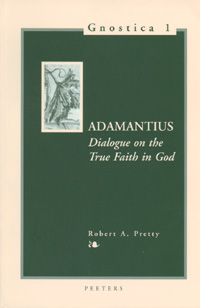 |
| Adamantius: Dialogue on
the True Faith in God; De Recta in Deum Fide Robert A. Pretty, translation and commentary; Garry W. Trumpf, editor. Gnostica: Texts and Interpretations, Belgium: Peeters, 1997. Reviewed by Laura Hobgood-Oster, Southwestern University, Department of Religious Studies The last two decades have provided a veritable plethora of documents for those interested in studying the relationship between various forms of Gnostic Christianity and what eventually became "Orthodox" Christianity during the first four centuries CE. Of course, during this time period, Christianity formed its basic belief system, oftentimes in response to the challenges from Gnostic groups. Much of the recent focus has been on those works found in the Nag Hammadi Library, discovered in Egypt in 1945. Prior to that discovery and its subsequent translations, historians of Christianity have relied upon scattered fragments or on the interpretations of Gnostic Christianity offered by its opponents - the Church Fathers, Orthodox Apologists, or gathered Councils. Adamantius, a Platonic-style dialogue, contributes the final translation to the corpus of Christian Gnostic literature. It is the last major piece to be translated into a modern language, thus making it accessible to broader audiences. The wait for such careful research and translation has been too long, it has also been worth it. Robert Pretty (1904-1985), who served on the faculties of Camden College and the University of Sydney as a professor of Early Church, devoted much of his life of scholarship to this text. It has been widely overlooked and with this publication, hopefully, its significance will be underscored. He does a commendable job of introducing this complex work and, in the process, provides an amazingly comprehensive overview of the issues of debate between orthodoxy and gnosticism. Needless to say, "heresies" abounded prior to the establishment of orthodoxy (to express such is something of an oxymoron) and a reading of the Adamantius provides one with an overview of many of these |
|
|
||
| heresies over which Christianity eventually defined itself. Adamantius dates from the late third or early fourth century CE, immediately before Christianity becomes a legal religion in the Roman Empire. The dialogue takes place between the following characters, each representing a particular position within early Christianity: Adamantius, the orthodox voice; Megethuis, a Marcionite who posits three governing Principles in the Universe; Marcus, a Marcionite who posits two governing Principles; Marinus, a follower of Bardenas who looks at two root Causes;Droserius, a Valentinian Gnostic, with some variations; and Eutropius, a pagan adjudicator who eventually espouses orthodoxy. The subtleties of debate regarding the nature of Christ, of God, of the Demiurge and other beings within the Gnostic cosmological construct, are fasincating. They are also clearly articulated by the different voices, which allows relatively easy access to the text. Of course, Gnostic Christianity is associated with types of knowledge and with the Unknown God, this esoteric knowledge being the core of "gnosis." If the reader takes to time to study the many notes, particularly the intricacy of interpretation and translation of a variety of Greek philosophical terms, some of the primary concepts of Gnosticism become readily apparent. In terms of an editorial critique, a significant number of typographical errors can be found in the text. They are particularly distracting as one must re-read to piece together the meaning. Indeed, occasionally the reader is unable to decipher which word is correct (for example, on page 27 of the "Introduction" the subheading "God the World" should, possibly, read "God the Word," but this cannot be determined definitely by the reader). Adamantius should be read by scholars of early Christianity and by those interested in Gnosticism in its various religious manifestations. |